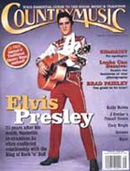25 Years After His Death, Nashville re-examines its often conflicted relationship with The King Of Rock 'n' Roll. This edition came out in July.
In the early hours of Aug. 16, 1977, Elvis Presley sat down at the piano in the lounge of the Graceland racquetball building to sing “Blue Eyes Crying In The Rain,” the Fred Rose classic Willie Nelson had included on his landmark Red Headed Stranger album two years earlier. It was the last song Presley would ever perform. Within hours, he would be dead at 42, a victim of bad habits, self-indulgence and unfulfilled dreams.
The fact that Elvis Presley ended as he began – with country music on his mind and in his lungs – was not especially remarkable. Still, the misconception lingers that Presley appreciated country only in his youth and in the earliest period of his recording career, and that he cast this love affair aside once he left Sun Records for RCA. In truth, aside from the early-to-mid-’60s, when the bulk of his recorded material came from the songs written for the soundtracks of his films, Elvis frequently recorded country tunes.
From childhood on, hillbilly, folk and Western music formed the roots of Elvis’ musical experience. Like many poor Southerners, the Presley family listened to the Grand Ole Opry on Saturday nights; Presley once remarked that the venerable radio program was probably the first music he ever heard. “Country music was always a part of the influence on my type of music,” he said in 1970. “It’s a combination of country music, and gospel, and rhythm and blues.”
Along with Pentecostal church hymns and white gospel – and the black music that he heard in the Tupelo community of Shake Rag, not far from his own Mississippi home – the young Presley found inspiration on Tupelo’s radio station WELO. Mississippi Slim, the host of the noon-time program Singin’ And Pickin’ Hillbilly, became Elvis’ first true role model.
As an 11-year-old, Presley frequented the station, working up the nerve to perform one day on a Saturday afternoon amateur show called WELO Jamboree. By that time, he’d already performed Red Foley’s “Old Shep” without accompaniment in front of an audience of several hundred at the annual Mississippi-Alabama State Fair and Dairy Show in Tupelo – standing on a chair so he could reach the microphone, and winning fifth place in the Children’s Day talent contest. He continued to sing the weeper about man’s best friend throughout the early years of his professional career.
As Elvis matured into a teenager, he listened not only to Foley, but also to Jimmie Rodgers, Bill Monroe, Ernest Tubb, Roy Acuff and Hank Williams, whom he would later come close to playing in a ’60s movie based on the doomed singer’s tragic life and death. He came to the music naturally, absorbing his mother’s interests. Gladys Presley was most definitely a country music fan.
Of course, Elvis’ love of country music was evident from his first recordings. His first single featured a fired-up R&B song, Arthur Crudup’s “That’s All Right (Mama)” on the A-side and Bill Monroe’s “Blue Moon Of Kentucky” on the B-side, which Elvis and producer Sam Phillips transformed from an elegant waltz to a rockabilly firecracker charged with the slurred vibrato that became Presley’s vocal trademark.
The details behind Elvis' rise to stardom and relationship with country await you in the current newsstand issue of Country Music Magazine.
Elvis' Country Roots In Country Music Magazine
September 02, 2002 | Other